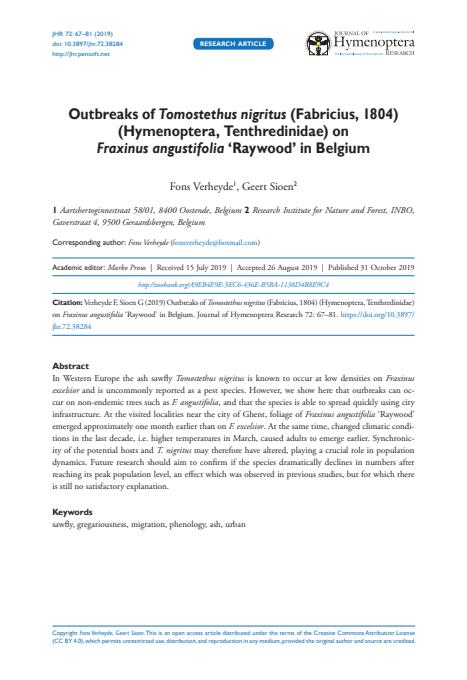Outbreaks of Tomostethus nigritus (Fabricius, 1804) (Hymenoptera, Tenthredinidae) on Fraxinus angustifolia ‘Raywood’ in Belgium
Details
| Number of pages | 15 |
|---|---|
| Volume | 72 |
| Pages (to-from) | 67-81 |
| Type | A1: Web of Science-article |
| Category | Research |
| Magazine | Journal of Hymenoptera Research |
| Issns | 1070-9428 |
| Publisher | Pensoft Publishers |
| Language | English |
Bibtex
@misc{ea51ba34-753b-4f77-87f3-8da2ae583f5d,
title = "Outbreaks of Tomostethus nigritus (Fabricius, 1804) (Hymenoptera, Tenthredinidae) on Fraxinus angustifolia ‘Raywood’ in Belgium",
abstract = "In Western Europe the ash sawfly Tomostethus nigritus is known to occur at low densities on Fraxinus excelsior and is uncommonly reported as a pest species. However, we show here that outbreaks can occur on non-endemic trees such as F. angustifolia, and that the species is able to spread quickly using city infrastructure. At the visited localities near the city of Ghent, foliage of Fraxinus angustifolia ‘Raywood’ emerged approximately one month earlier than on F. excelsior. At the same time, changed climatic conditions in the last decade, i.e. higher temperatures in March, caused adults to emerge earlier. Synchronicity of the potential hosts and T. nigritus may therefore have altered, playing a crucial role in population dynamics. Future research should aim to confirm if the species dramatically declines in numbers after reaching its peak population level, an effect which was observed in previous studies, but for which there is still no satisfactory explanation.",
author = "Fons Verheyde and Geert Sioen",
year = "2019",
month = oct,
day = "31",
doi = "https://doi.org/10.3897/jhr.72.38284",
language = "English",
publisher = "Pensoft Publishers",
address = "Belgium,
type = "Other"
}

